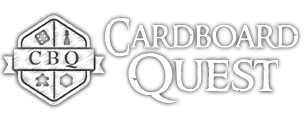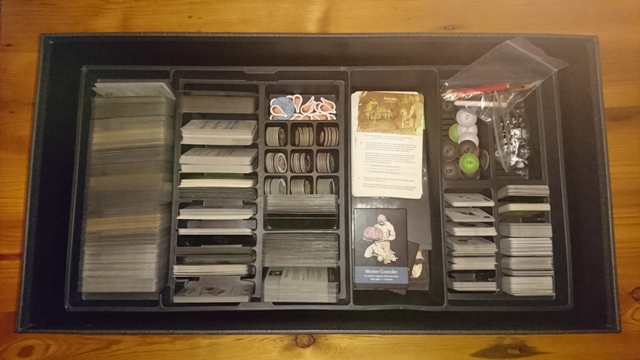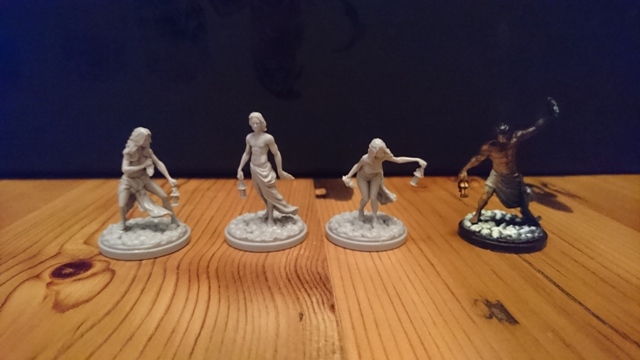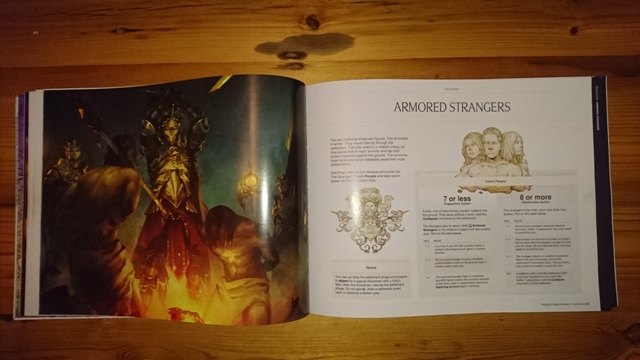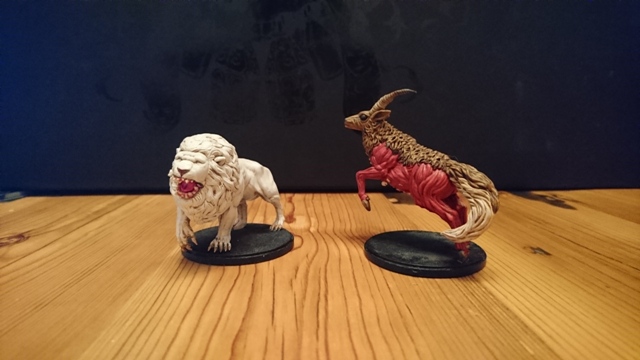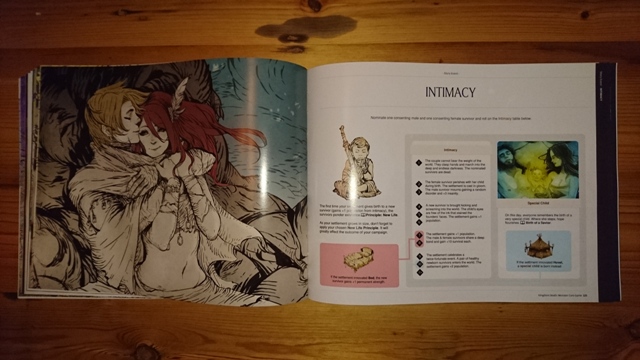Kingdom Death: Monster – Guest Feature
Kingdom Death: Monster describes itself is a “Boutique Nightmare Horror” boardgame, and it’s certainly known for it, be it describing its disturbing menagerie of body-horror monstrosities, or its astronomical price. Originally announced on Kickstarter in November of 2012, the project fulfilled its goal of $35,000 dollars within 1.5 hours, and would go on to make over $2,000,000 in a then record making kickstarter turn out for boardgames.
Unfortunately, with a massive jump in projected income came a massive jump in project scale, which resulted in massive delays as a new studio tumbled into the deep-end world of design, distribution, and production. With no creative control to hold him back, the creator went wild, unwilling to sacrifice his creative vision to achieve a timely release. Finally releasing towards the end of last year, I finally got my copy of Kingdom Death in my hands (I spent a fantastically large amount of money on the kickstarter), and played through a full campaign.
So how did it turn out? Well, the final product is, if nothing else, extremely impressive to look at. The presentation is simply off the charts, from the artwork on the rulebook, to the cards, to the tokens, it’s difficult to think of any other game, or any project for that matter, that put this much work into its visuals. The art, though the quality does vary within the rulebook, is collectively astounding.
The miniatures are similarly shocking in their high quality, meeting (if not exceeding) the big names in miniatures. Though some of the most amazing models are found in expansions, one can’t scoff at what’s presented in the core box.
Starting a new game, one discovers that the narrative is intentionally very vague. Your initial characters, or survivors as the game calls them, find themselves waking within a world of no natural light with no memory of who they are, or their past. Lying naked (barring a convenient loin cloth) on a landscape of endless stone faces peering upwards, all they have are each other, and the single lantern each seems to hold.
The world of Kingdom Death is built upon the theme of the human body to perverse proportions. Creatures all sport human qualities, human mouths and faces are commonly found sprouting in all lifeforms from insects to trees, and it’s woven into the very world itself. Humanity as we know it is at the bottom of the food chain, a basic food source for the wildlife, or chattel for the more powerful entities. It’s difficult to decipher if this is a result of some reality breaking calamity, or simply just how reality is here.
The campaign of Kingdom Death: Monster revolves around survivors finding a safe haven, a gigantic hoard of lanterns, and eking out a living by hunting far more dangerous creatures than themselves, breeding, and ultimately building up a settlement they can call home while surviving the nightmarish onslaught such a world continuously throws at them. The game is highly lethal, with survivors dying often and unexpectedly.
The gameplay starts with the players combating a uniquely easy enemy, allowing them to learn the basics behind the game’s combat. After this, their characters find other survivors, and together they establish their settlement from which they will depart from and return to when hunting. From here on out, the game is split into “Lantern Years”, each year being split up into three phases: the Hunt phase, the Showdown phase, and the Settlement phase.
The first phase every Lantern Year is the Hunt phase. Having chosen their quarry, as well as its level, the players stalk their prey by following it on a track. Each space they enter sees a random event happen which can either help or hinder the survivors either in the long run or only for the upcoming battle. These encounters are great for providing small bits of world building, as well as humour, in addition to the marvels and disasters they may bestow. Once the survivors reach the space their prey is in, and more difficult prey is farther away, the show down begins.
Here the four survivors face down their prey. The Showdown phase is by a massive margin the main meat of Kingdom Death, and where players will spend the vast majority of their gaming time. The combat alternates between the Monster phase, where it acts, and the survivor phase, where they act in turn, and continues until either are wiped out. Successfully defeating their prey sees it drop a random assortment of harvestable resources, including anything they may have found scattered on the battlefield.
Combat is involved and lengthy, comparable to combat in tabletop wargaming or roleplaying. The survivors combat the beast on a grid; moving, striking, and avoiding retaliation. The monster mostly activates first, after which the survivor players activate in any order they wish. This turn order repeats until death finds a favourite.
When monsters activate, the player controlling it draws the top card of its AI deck, which describes an attack, the target of the attack, and how that attack functions.
A survivor’s turn consists of two actions: movement and “activation”. Movement is self-explanatory; you move a number of spaces equal to your movement value, no diagonal movement or passing through other survivors allowed. Activation is activating any piece of usable gear you may have equipped, most often weapons. Attacking itself has two parts: hitting and wounding.
When hitting, your weapon dictates how many dice you roll and what you need to hit, and for each hit you get you draw a card from the monster’s Hit Location deck. These cards represent hits striking the monster on different parts of its body and how it would react, inflicting penalties or rewards depending on whether the wound attempt is successful. Players then roll a single dice for each card drawn, and wound the monster if they roll higher than the monster’s Toughness value. Additionally, if a player managed to roll a perfect 10 when wounding, they critically wound the beast, resulting in potential rewards or enforcing permanent disabilities to the monster.
Each successful wound roll sees the players take the top card of the monster’s AI deck and place it in the Wound pile, permanently removing it as an attack option for the monster. When the monster has no AI cards left and is dealt one more damage, it is defeated. The result is that as the monster takes damage, it becomes increasingly predictable as fights.
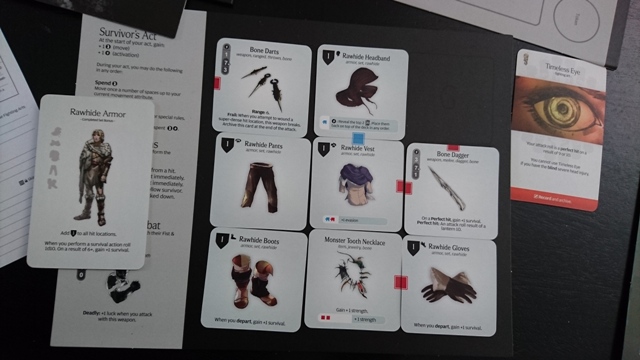
An example of an early game survivor’s gear grid. Having a full set of rawhide armour gains the benifit of the full set bonus (card on the left). They’re also using a Fighting Art they had learned (card on the right) to boost their gear synergy.
Things are rather simpler when it comes to dealing damage to survivors. Whenever monsters hit survivors a Hit Location dice is rolled for each hit, dictating which part of the body is struck and damaged. Those locations then individually suffer damage, first tearing away at any armour if present, and then dealing damage to the body. When a body section has suffered more damage than it can withstand (most only have two health), players roll on damage tables that relate to that section, resulting in severe penalties, limb loss, or immediate death depending on how bad the roll is. If several body sections are damaged in this way, the player rolls once on each relevant table.
After each successful hunt, the still living survivors return with the materials scavenged from their kill, they gain Hunt Experience, and the Settlement phase begins. This is always headed off with a random settlement event that can either help or hinder, as well as any events scheduled on the settlement’s timeline, such as those that unlock new monsters to hunt. After this, players will discuss what structures to build, what gear they craft, and how to innovate to further develop their culture for campaign-long buffs. Due to the many deaths that will inevitably happen, Intimacy is an important event to follow in order to breed survivors and create more children to replace the deceased – though it’s a testament to the game’s grim nature that death can even be found here. Finally, after all this, players then choose what they will hunt next, and the phase ends, with the start of a new Hunt phase.
Occasionally, rather than hunting a monster, the settlement is instead attacked by a particularly powerful enemy. These are far more dangerous than those creatures one may choose to hunt, in part because players have no control over when they attack – though they are aware of when they will attack – and in part because they are either far more intelligent and capable foes, or simply utterly overwhelming. It’s normal to go into each of these fights with the knowledge that you’re sending everyone in to die, and victory normally comes at a great cost of life. Rewards for victory are meager, but potentially very desirable.

An example of an early to mid-game settlement phase (sans resources and gear cards that may be being discussed / used and made)
Eventually after twenty five Lantern Years (though the exact year can possibly change), players will have their final encounter with the game’s boss. The chief encounter in the game, the players have hopefully nurtured their settlement to produce both powerful enough warriors and powerful enough gear to face down this threat. The game ends in failure if the players fail to overcome this challenge, or if their population is ever reduced to zero before then.
Overall, Kingdom Death: Monster is a game I very much enjoy. For all its darkness, the game also has a lot of humour hidden in it, all the more funny for how absurd it is in the face of the daunting dread that surrounds the game everywhere else – the game has a wonderful collection of hidden surprises in random events or even enemy card names or ability. There are innumerable references to pop culture as well, though they vary in how obvious they may be to recognise.
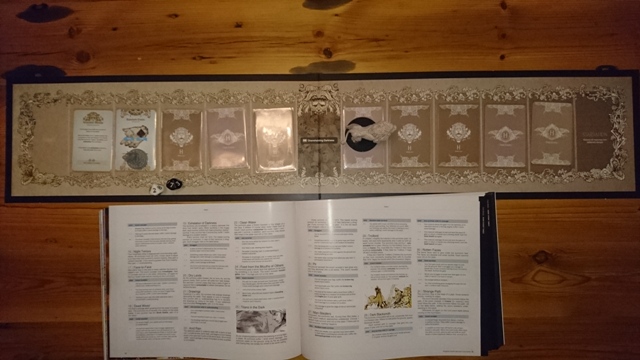
An example of the hunt phase, the survivors move along the track from left to right hoping to catch up to the monster.
I’ve found artwork that subtly yet definitely reference certain visual memes, and have myself found an “Adventure Sword”, clearly inspired by Adventure Time. There’s also a terrific sense of parental pride seeing survivors make through the hunts and grow in power, though this naturally means one gets dangerously attached. The game’s encouragement to name survivors through resulting bonuses is a rather devious way to further enhance attachment.
The scale of its mechanics can seem preposterous to some, (and indeed at least one person was put off by both the mechanics and what he felt was immersion breaking humour and references) but I’ve loved how the mechanics such as the Hit Location and AI deck add character and make the game stand out.
One of the most interesting aspects of Kingdom Death is how it individualises the different monsters when combating them, primarily through the AI Deck and Hit Location deck. Each monster has its own pair, and they cleanly illustrate how they all act differently when being aggressive or defensive.
The White Lion tends to rush in to brawl, and will often retaliate with force when struck. The Screaming Antelope, on the other hand, is highly mobile, constantly moving to run down farther threats, healing itself, and fleeing when attacked. Particularly as one fights the higher levels of each monster, their individual mannerisms are highlighted.
The game is challenging to play, though it’s the type of challenge that one looks forward to surmounting. The despair of loss is more about the loss of valuable assets – powerful survivors you were weaning, or valuable gear, rather than a complete game loss, and as such the resulting despondency rarely lasts long as one picks new survivors to take out. Victory is immensely satisfying, as are many small things that result from chance rolls. There have been few games where I’d already died, yet emphatically cheered when I see my team mates score great hits and survive against targets that are thrashing us.
There are many do-or- die situations, both in combat or when trying to draw that one innovation that would blunt the severity of a particularly harsh settlement event, and the good luck is often remembered over the bad. The game is exhausting, though. A lot happens in each “year”, and the constant sense of risk during the long bouts of combat that it weighs heavy on the mind. While I looked forward to our weekly sessions, anything more regular than that became overbearing.
While we initially found the combat to be very samey – move behind the monster and hit it, rinse and repeat – as the monsters increased both in difficulty and capability we found that how we moved become extremely important and varied depending on what we were fighting. The decisions you make while moving and attacking aren’t ground-breaking when it comes to mechanics, but coupling it with the great risk and unpredictable behaviour of monsters definitely adds spice that makes the combat very enjoyable in a “oh god everyone is dead” kind of way. Being able to overcome enemies, particularly the nemesis encounters, is highly satisfying and the sentiment of “we survived!” is commonplace.

A showdown between survivors and a magnificent white lion. Let the details soak in, this is how you’ll spend much of your gameplay
The Settlement phase was also particularly interesting, as it involved several important decisions pertaining to which gear we were going to make with the scarce few resources we had, how to combo gear load outs to get the best out of it, which settlement locations to build and ultimately how to advance our society in general. The mechanics for how gear works and can provide additional buffs depending on what you have and where you place it is really interesting, not to mention the desirable full set bonuses.
It’s through the gear that one is able to produce survivors with particularly powerful or effective ability synergies that can dampen the severity of harsh encounters. There’s also a nice element of roleplaying to be found here, as players nominate survivors for certain tasks in hopes of achieving certain boons, or suffering punishing failure, and the results often leave permanent marks for good or ill.
However, with all this praise, there are some frustrations. For example, there were times where it felt that combat in which we all died horribly, in which we knew we were all going to die horribly, was unavoidable. This related specifically to the nemesis encounters, which we knew were coming, but often just died anyway. While losing everyone was a fact that we had accepted, when you’re going into a fight you can’t avoid it’s a bitter pill to swallow.
It’s entirely possible that this was a result of us simply being behind the curve when it came to technology and character growth, which we definitely were, but the fact remains that this can happen – though I suspect actually knowing what we were doing would definitely have helped us in our earlier years.
It’s important to note that luck at times can very much be a factor that decides if you manage to defeat an enemy you had no right to overcome, or die horribly to an enemy you should have easily bested. Luck in general plays a large role, which isn’t surprising considering the large amounts of dice rolling there is in and outside of combat. While this isn’t an innate problem, it may definitely bother players who dislike such an abundance of randomness.
In general, there are some things that definitely need to be considered when looking to purchase, or even partake in a Kingdom Death: Monster campaign.
- The game costs a buttload. You’re looking to pay $400 for the core set alone, and another $40-50 for shipping. While what you get certainly represents that pricing, it’s a massive amount of money to invest into anything, and will likely see only a very small niche group buy in at all.
- The game is long. Expect around 1 to 2 hours for every “year”, most of that taken up by combat. For a full campaign, you’re looking at around 45 hours of total playtime.
- All the miniatures come unpainted and unassembled. While many love this, I know several who prefer ready-to-play figures.
- Your favourites will die. If you’re the type to get attached, be warned that loved characters can die horribly, even outside of combat – a narrative dice roll brought about by an event during the settlement or hunt phase can immediately kill a character.
Ultimately, the Boutique nature of the game is highly apparent when you look at who may or may not enjoy it. It definitely appeals to a niche crowd, both in taste and in finances, but for that crowd it’s definitely a fantastic game.
CBQ would like to give a huge thanks to Daniel Hallinan for so wonderfully encapsulating the experience of wrestling with this ambitious, sprawling and wholly original boardgame. Follow him at @Kharrak, though we can’t promise you won’t regret it…
-
David
-
Gerhard
